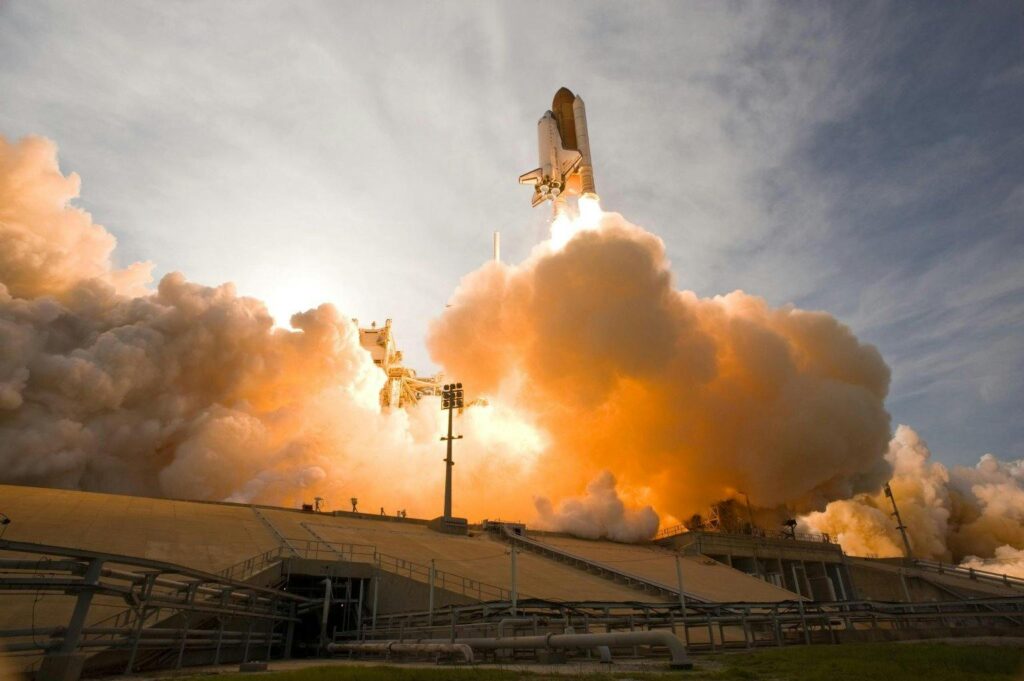Table of Contents
On January 19, Blue Origin, the aerospace company founded by Jeff Bezos, will take a monumental step in its journey toward space dominance with the inaugural launch of its massive New Glenn rocket. This highly anticipated event marks the company’s entry into the Earth orbit arena and sets the stage for heightened competition with industry leader SpaceX.
Standing at an impressive 30 stories tall, New Glenn represents the culmination of over a decade of work and billions of dollars in investment. Designed to meet the growing demand for satellite launches and rival SpaceX’s Falcon 9 rocket, New Glenn’s success could reshape the landscape of satellite-based internet services and commercial space exploration.
New Glenn: A Decade in the Making
Blue Origin has long been associated with its suborbital New Shepard rocket, which reached the edge of Earth’s atmosphere and returned safely to the ground. However, New Glenn is a different beast entirely. This two-stage rocket is built to deliver payloads into orbit, a feat the company has not yet accomplished despite 25 years of operation.
New Glenn’s launch is scheduled for 1 a.m. ET on January 19 from Blue Origin’s launch pad at Cape Canaveral Space Force Station in Florida. The rocket will carry Blue Ring, the company’s first satellite, intended for a national satellite and security service mission. If successful, the launch will establish Blue Origin as a serious player in the orbital launch market.
A Challenger to SpaceX
Blue Origin’s ambitions with New Glenn go beyond achieving orbit. The rocket is designed to compete directly with SpaceX’s Falcon 9, currently the most active and reliable rocket in the world. While the Falcon 9 has revolutionized the satellite launch industry with its reusable first stage and competitive pricing, New Glenn brings several unique features to the table:
- Twice the Thrust: New Glenn boasts double the thrust of Falcon 9, providing greater lift capacity for larger payloads.
- Larger Payload Volume: The rocket features a wider payload fairing, allowing it to transport more satellites or larger equipment per mission.
- Focus on Reusability: Like the Falcon 9, New Glenn’s first stage is designed to return to Earth and land on a drone ship for reuse.
Despite its technical advantages, pricing remains a mystery. While SpaceX offers Falcon 9 launches starting at $62 million, Blue Origin has yet to disclose New Glenn’s cost, which will be a critical factor in securing commercial contracts.
The Kuiper vs. Starlink Rivalry

The competition between Blue Origin and SpaceX extends beyond rockets to the satellite-based internet market. Blue Origin’s New Glenn is expected to launch Amazon’s Kuiper broadband satellite constellation, a direct competitor to SpaceX’s Starlink network. Both networks aim to provide high-speed internet to underserved regions worldwide, creating a competitive environment that could drive innovation and lower costs for consumers.
Amazon has already secured FCC approval to deploy over 3,000 satellites for Kuiper. A successful New Glenn launch could accelerate the rollout of this service, intensifying the rivalry between Bezos and Elon Musk.
Challenges and Setbacks
New Glenn’s journey to the launch pad has been far from smooth. Over the years, Blue Origin has faced numerous obstacles, including:
- Frequent Leadership Changes: The company has gone through three CEOs during the rocket’s development. In late 2023, Dave Limp, a former Amazon executive, was appointed CEO to drive the project to completion.
- Resource Diversion: Development delays were compounded by Blue Origin’s focus on other ambitious projects, such as building lunar landers for NASA.
- Industry Pressure: The rocket industry is highly competitive, with established players like SpaceX and United Launch Alliance (ULA) dominating the market.
Despite these setbacks, Blue Origin employees describe a singular focus on ensuring the success of this inaugural launch. “The entire company has been working toward this one goal,” said an employee.
A Crucial Certification Flight
The upcoming launch isn’t just a demonstration of New Glenn’s capabilities—it’s also a certification flight for the U.S. Space Force. If successful, New Glenn will qualify to carry national security payloads, unlocking billions of dollars in government contracts. These lucrative opportunities are essential for Blue Origin to establish itself as a sustainable player in the commercial space sector.
The U.S. government’s interest in reliable and cost-effective launch vehicles underscores the importance of this mission. Success could position Blue Origin as a viable alternative to SpaceX for national security missions.
The Future of Commercial Space Exploration

New Glenn is not only competing with SpaceX’s Falcon 9 but also with Starship, SpaceX’s next-generation fully reusable rocket. While Starship is designed for deep-space missions and interplanetary travel, New Glenn aims to dominate the Earth orbit market with its impressive payload capacity and reusability features.
In addition to SpaceX, Blue Origin faces competition from other players like ULA, Rocket Lab, and emerging companies vying for a share of the satellite launch market. With growing demand for satellite-based internet and other orbital services, the commercial space industry is poised for rapid expansion in the coming decade.
Key Technical Features of New Glenn
- Height: 30 stories, making it one of the tallest rockets in the world.
- Payload Capacity: Designed to carry a wide range of payloads, from small satellites to heavy equipment for national security missions.
- Reusability: The first stage is designed to land on a drone ship after launch, reducing costs for subsequent missions.
- Launch Site: Cape Canaveral Space Force Station, a historic location for space exploration.
What’s at Stake for Blue Origin?
For Blue Origin, the stakes couldn’t be higher. Successfully delivering a payload into orbit would validate years of work and billions of dollars of investment. It would also mark a turning point for the company, transitioning from a suborbital space tourism provider to a serious contender in orbital launches.
Moreover, a successful New Glenn launch would bolster Blue Origin’s reputation as a reliable partner for government and commercial clients. This credibility is essential for securing contracts in an industry where trust and reliability are paramount.
Why This Launch Matters
The inaugural flight of New Glenn isn’t just about Blue Origin’s success—it’s about the future of space exploration. The rocket’s capabilities could enable:
- More Affordable Access to Space: Increased competition in the rocket industry could drive down launch costs, making space more accessible to startups, researchers, and governments.
- Advancements in Satellite Internet: The Kuiper constellation promises to bring high-speed internet to underserved regions, bridging the digital divide.
- New Opportunities for Science and Security: With its large payload capacity, New Glenn could support scientific missions, national security projects, and commercial endeavors.
Conclusion
Blue Origin’s New Glenn rocket represents a bold step forward in the company’s pursuit of space exploration. Its inaugural launch on January 19 is a defining moment that could reshape the commercial space industry and intensify competition with SpaceX.
Whether it’s enabling Amazon’s Kuiper constellation, carrying national security payloads, or driving innovation in satellite launches, New Glenn has the potential to leave a lasting mark on the industry. As the world watches this historic event, one thing is clear: the race for dominance in space is far from over, and Blue Origin is determined to be a key player in this new frontier.





